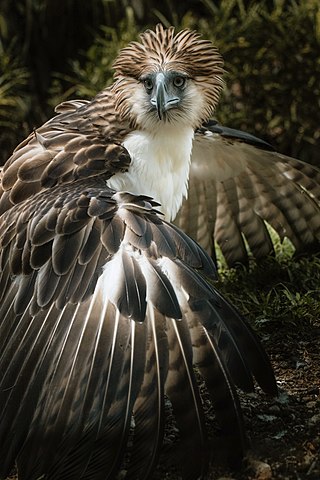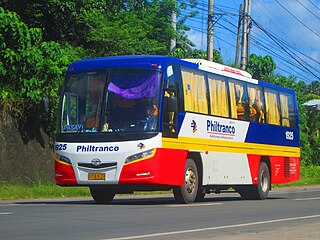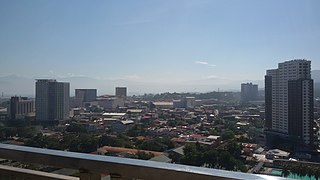Related Research Articles

The Philippine eagle, also known as the monkey-eating eagle or great Philippine eagle, is a critically endangered species of eagle of the family Accipitridae which is endemic to forests in the Philippines. It has brown and white-colored plumage, a shaggy crest, and generally measures 86 to 102 cm in length and weighs 4.04 to 8.0 kg.

Davao City, officially known as the City of Davao, is a first class highly urbanized city in the Davao Region, Philippines. The city has a total land area of 2,443.61 km2 (943.48 sq mi), making it the largest city in the Philippines in terms of land area. It is the third-most populous city in the Philippines after Quezon City and Manila, and the most populous in Mindanao. According to the 2020 census, it has a population of 1,776,949 people.

Opol, officially the Municipality of Opol, is a 2nd class municipality in the province of Misamis Oriental, Philippines. According to the 2020 census, it has a population of 66,327 people.

Sisig is a Filipino dish made from parts of a pig's face and belly, and chicken liver which is usually seasoned with calamansi, onions, and chili peppers. It originates from the Pampanga region in Luzon.

Philippine Rice Research Institute (PhilRice) is a government corporate entity attached to the Department of Agriculture created through Executive Order 1061 on November 5, 1985 to help develop high-yielding and cost-reducing technologies for farmers.

The Christian And Missionary Alliance Churches of the Philippines (CAMACOP) is a Christian evangelical group in the Philippines that originated from The Christian and Missionary Alliance (C&MA). It is one of the largest evangelical groups in the Philippines.

Philtranco Service Enterprises, Inc. is a bus company in the Philippines, servicing routes to Bicol, Eastern Visayas, Caraga, Davao Region, and Northern Mindanao. It is the oldest bus operator in the Philippines and in Asia. It is also the only bus carrier with a nationwide public transport franchise. Philtranco currently has more than 250 buses for its operations.

Agriculture in the Philippines is an important part of the economy of the Philippines with crops like rice, coconut and sugar dominating the production of crops and exports. It employs 23% of the Filipino workforce as of 2021, according to the World Bank.

The following outline is provided as an overview of and topical guide to the Philippines:

A crocodile farm or alligator farm is an establishment for breeding and raising of crocodilians in order to produce crocodile and alligator meat, leather from crocodile and alligator skin, and other goods. Many species of both alligators and crocodiles are farmed internationally. In Louisiana alone, alligator farming is a $60 to $70 million industry.

Metropolitan Cagayan de Oro, also known as Metro Cagayan de Oro, is the fourth largest metropolitan area in the Philippines. It is located on the northern coast of Mindanao, and comprises the two chartered cities of Cagayan de Oro and El Salvador and the fourteen municipalities of Misamis Oriental which are Alubijid, Balingasag, Claveria, Gitagum, Initao, Jasaan, Laguindingan, Libertad, Lugait, Manticao, Naawan, Opol, Tagoloan, and Villanueva and the six municipalities of Bukidnon which are Manolo Fortich, Baungon, Libona, Malitbog, Sumilao and Talakag. According to the 2015 Philippine census, Metro Cagayan de Oro has a population of 1,687,159 people.
The Philippine Cyberservices Corridor is a plan that is being pursued by the government of the Philippines to create interconnected centers of technology-related services, that are spread out all over the country. Services include business process outsourcing, medical transcription, outsourcing of animation, and the like. It is part of the ten-point agenda of President Gloria Macapagal Arroyo and is one of the five "super-regions" outlined in her 2006 State of the Nation Address.

Cagayan de Oro (CDO), officially known as the City of Cagayan de Oro, is a 1st class highly urbanized city in the region of Northern Mindanao, Philippines. It is the capital of the province of Misamis Oriental where it is geographically situated but governed administratively independent from the provincial government. According to the 2020 census, it has a population of 728,402 people.
Megaworld Corporation is a real-estate company in the Philippines. It is listed on the Philippine Stock Exchange Composite Index. The company develops large-scale, mixed-use, planned communities incorporating residential, commercial, educational, and leisure components. In addition it provides other services such as project design, construction oversight, and property management. Among its landmark projects is Forbes Town Center, a 6-hectare commercial and residential district in Fort Bonifacio, Taguig, Metro Manila. Another project by Megaworld is the 45-storey Petron Megaplaza office skyscraper, which was the tallest building in the country upon its completion in 1998. Also, last May 31, 2016, Megaworld announced that they will build two more office towers, 10-storey One Republic Plaza, and six-storey Emperador House, in Davao City. The two towers will provide an additional 30,000 sqm of office spaces for lease.

As of 2005, the Philippines was the ninth largest sugar producer in the world and second largest sugar producer among the Association of Southeast Asian Nations (ASEAN) countries, after Thailand, according to Food and Agriculture Organization. At least seventeen provinces of the Philippines have grown sugarcane, of which the two on Negros Island account for half of the nation's total production. As of crop year 2009-2010, 29 sugar mills are operational divided as follows: thirteen mills on Negros, six mills on Luzon, four mills on Panay, three mills in Eastern Visayas and three mills on Mindanao.

Crocodile farming in the Philippines refers to agricultural industries involving the raising and harvesting of crocodiles for the commercial production of crocodile meat and crocodile leather.
Monark Equipment Corporation is a family-owned Filipino corporation, and is a dealer and importer of heavy equipment and generator sets. It is the exclusive authorized dealer of Caterpillar products in the Philippines and prominently features the Caterpillar logo and the Caterpillar Yellow livery as part of its company logo. It distributes other European and North American brands, including Tadano cranes, Heavy Equipment and Industrial Tires, and Putzmeister Concrete Pumps. The company is a member of the Monark Group of Companies.
Sta. Lucia Land, Inc. is a real estate development company based in the Philippines. The firm serves as the real estate arm of the conglomerate, Sta. Lucia Group
References
- 1 2 3 "About us, Philippine Ostrich & Crocodile Farms, Inc. PIONEERING THE OSTRICH INDUSTRY IN THE PHILIPPINES". Philippine Ostrich & Crocodile Farms, Inc. Retrieved 26 December 2013.
- 1 2 3 "Philippine Ostrich & Crocodile Farm". Municipality of Opol (08 October 2013). Retrieved 15 January 2014.
- 1 2 3 4 Tacio, Henrylito D. "Why you should raise ostrich". Sun.Star Davao (18 January 2010), Sun.Star Publishing, Inc. Archived from the original on 24 December 2013. Retrieved 28 December 2013.
- 1 2 3 Jimenez, Fidel. "Ostrich raising a promising business in RP". GMA News Online (23 May 2008). Retrieved 28 December 2013.
- ↑ Mangalus, Jane (PTD editor). "Ostrich Farm in San Luis, Pampanga". Philippine Tourist Destinations (March 19, 2012). Retrieved 14 January 2014.
{{cite web}}:|first=has generic name (help)